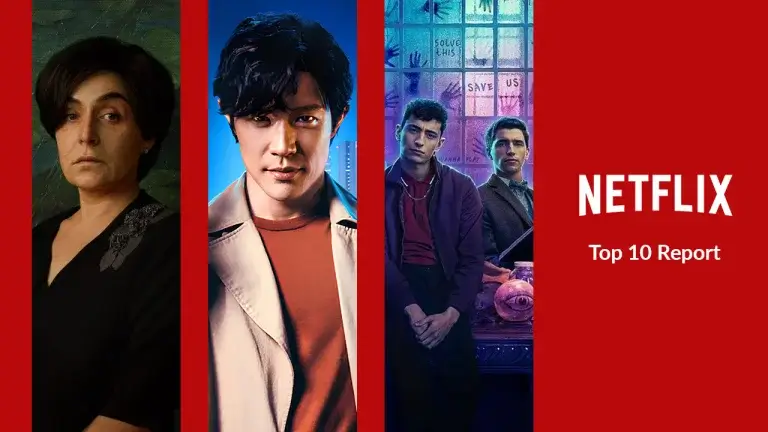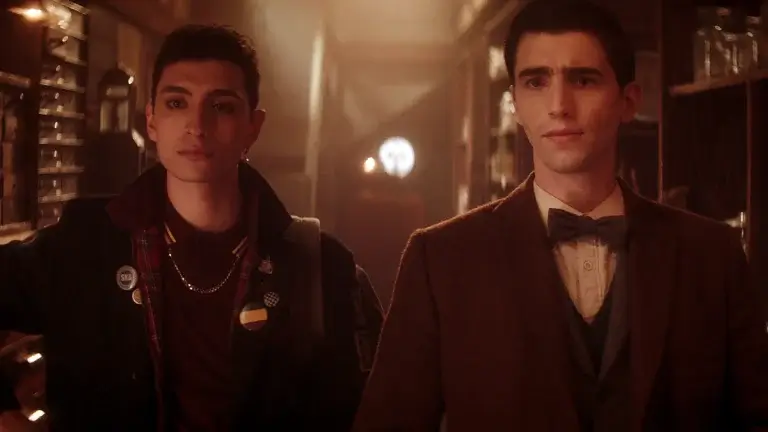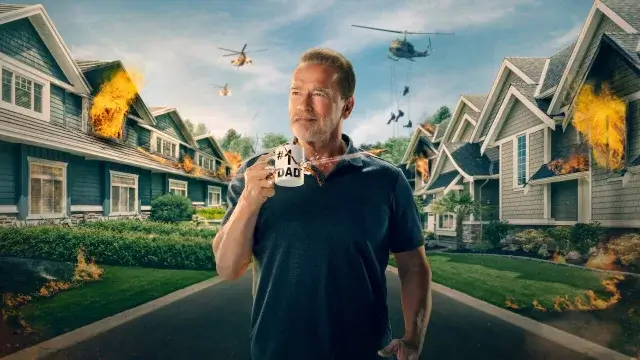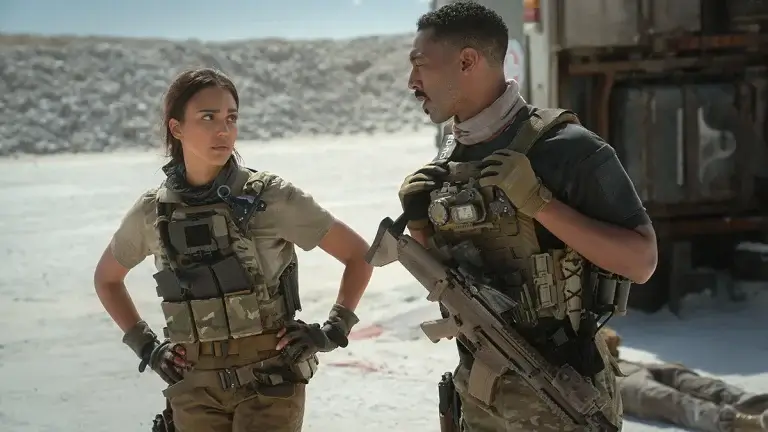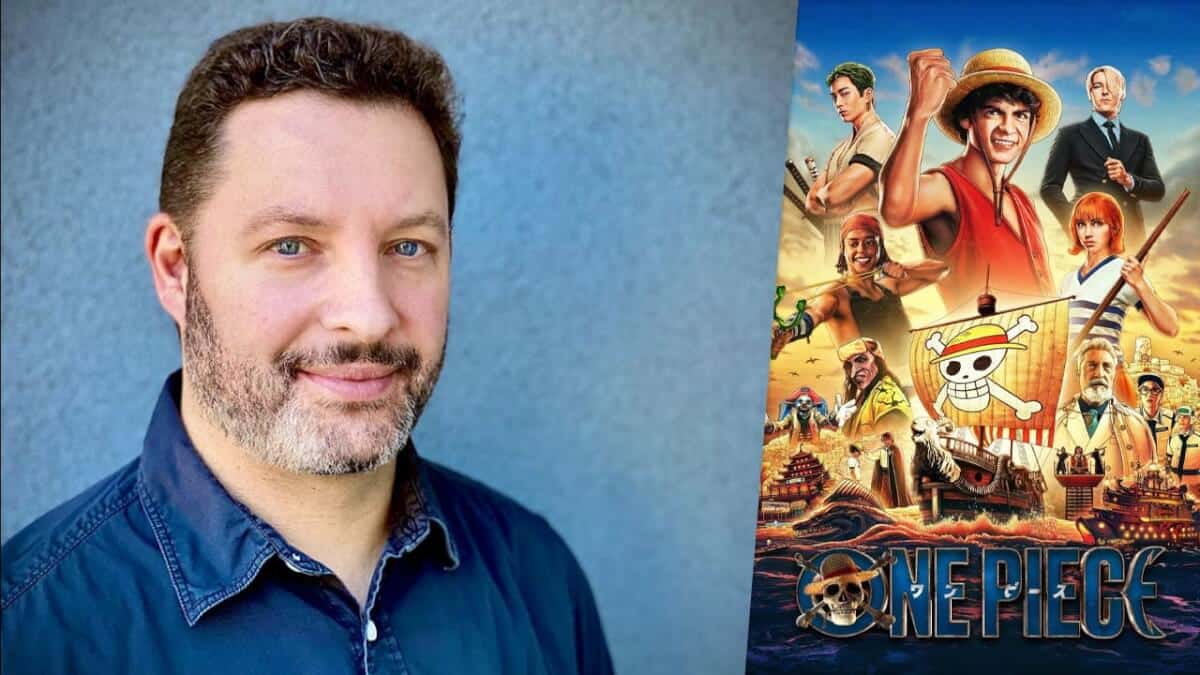
Picture: Eric Litman
The One Piece live-action series has been a huge success for Netflix and has since been renewed for a second season. What’s on Netflix recently had the opportunity to interview Eric Litman, one of the talented editors of One Piece.
One Piece is the first live-action adaptation of Eiichiro Oda’s beloved manga of the same name, which was created by Steven Maeda and Matt Owens.
Before working on One Piece, Eric Litman worked on Marvel’s Agents of S.H.I.E.L.D., the Magnum P.I. reboot, Black Sails, Revenge, and Star Trek Picard.
How did you first become involved with One Piece?
Eric: Well, I worked on Agents of S.H.I.E.L.D. for seven seasons, and I had the privilege of working with Matt Owens [One Piece showrunner], who was a writer-producer on that show. So, he and I had a history together, and the episodes we did were always a lot of fun, massive, and they always turned out great. So, when that show ended, I heard he was doing One Piece. I reached out to him, and he said, I’d love to get you on board, as we’re working on a script right now. Unfortunately, there was a pandemic in between all of that. So, a few years went by. I wasn’t sure what the status was of the show; I didn’t know if it went away.
Then, shortly after things started to reopen again, I reached out to Chris Symes over at Black Sails, there’s another show that I worked on, and just said, I’m looking for work, I know of this show that you guys are doing. And he said I’d love to get you on board, then reached out to Matt again, and he said, I haven’t forgotten about you.
Jacob: The One Piece live-action series was a long time in the making.
Eric: It was actually a number of years. It was a few years before I was even aware of it. And then, this was like October or November of 2019 when I started talking to Matt, and then there was a big gap. Then I didn’t hear back from them in a serious capacity until, like, maybe a couple of years later. Even then, when I interviewed for the pilot and took the meeting, it was a big Zoom call with people in South Africa, some in Australia, and I was in the States.
Then, several months went by, and I didn’t hear anything. I thought that was a bummer, I guess I didn’t get it. Then I got a phone call that said, Hey, we want to bring you on for episodes three and four. Which I’m extremely proud of. I did those episodes, and they turned out really well.
The pilot was still very much in flux. The original editor, Kevin Ross, who was on for an extended period, had to go to his next show. Then there was Tessa Verifas, one of the editors in South Africa, and she had taken over the pilot for a brief period. She then had to go on to something else. So, they let me take over the pilot. I dealt more with studio notes, some of Oda’s, which were terrific. In his notes, you’d have little illustrations of the characters. So that was cool. And on that, we primarily concentrated on the opening of the show because One Piece is such a diverse, unique world. I went with the pilot.
Jacob: So, helping to set the stage for the grand pirate Odyessy?
Eric: Yes, as you well know, One Piece is a lot of genres put together. There’s steampunk, there’s pirates, there’s modern technology, old technology, different technology. So it was a challenge to really explain where we are and how we get into that world. For example, you have to know who Gold Roger is because if you don’t, then the whole concept of the show might not work.
It was a great experience doing that because we had a great visual effects department, Victor Scalise, and Scott Ramsey. It was a great collaboration because we would get some notes and discuss how we got into this world. And I would tell the guys, what if we had a shot that did this, and they would quickly temp it out for me, and you cut it into the show. Then that would springboard into something else and something else.
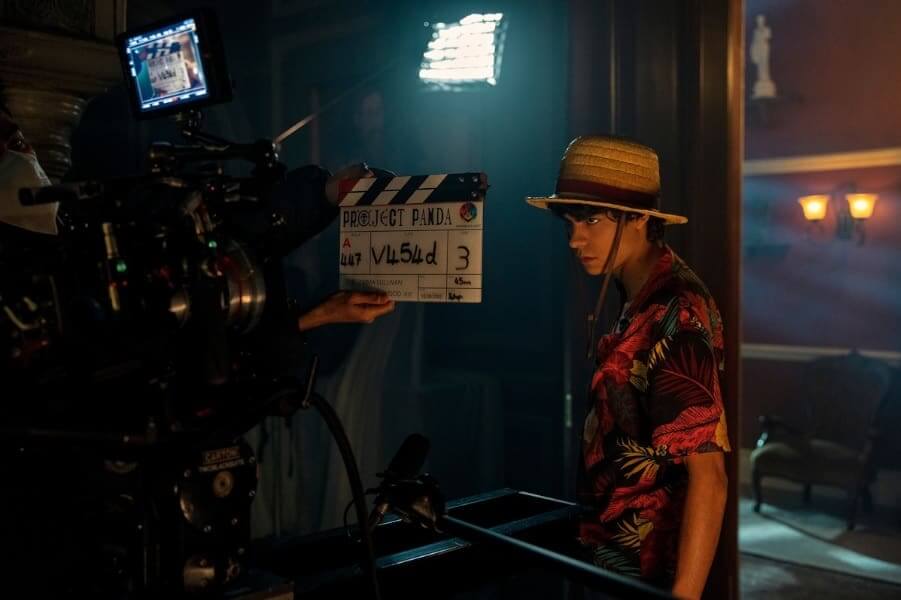
Picture: Iñaki Godoy as Luffy – Casey Crafford/Netflix
How early into production does the editing process start? Are you waiting for an episode to wrap, or are you already sifting through hours of footage?
Eric: So, when I came onto the show, I initially started at episodes three and four. three other teams were working on their specific blocks of episodes, and they cut into their specific blocks. So, Kevin Ross, the original editor of the pilot, handled the first two episodes, I handled three and four. On my block, I had director Emma Sullivan, and she did an absolutely terrific job. I loved working with her. she was highly collaborative, and gave me such rich fun material and a lot of options to work with.
So when I came on, there were already other episodes in various stages from other teams, so I was able to watch that and get an idea of what we’re setting out to do. At the end of each day, I would get footage of stuff Emma was shooting and I would cut it. The great thing about Emma is I would send her scenes, primarily at the end of each week, and we would discuss them over email or FaceTime, and try to reach objectives for her what her goal was with certain scenes. Fortunately, there wasn’t a lot of revision. I could see really quickly that she and I were on the same page, which was great.
Jacob: There’s a lot of collaboration in the process there. What about Steve and Matt as the showrunners? Were they involved in any of the editing? Did they have any opinions to share?
Eric: Yeah, they were very involved. When I came onto the show, they were already deep into production, and they were in South Africa, so there was a bit of a time difference. But we could communicate through email or sometimes get on PAC posts. We’d be reviewing scenes, and discussing if there was anything they were concerned about and how we could look at it quickly, resolve it, and ask for additional footage. Fortunately, that didn’t happen often. We had a terrific team in South Africa, so they were thrilled with everything they saw.
Once production wrapped, they were very involved. They would give me their notes, and we would execute in the room. The great thing about them is that they would give me broad strokes, tell me what they were thinking, and ultimately try to get to and give me the time to see what I could come up with. It was great to work like that. We’d also get some notes from Netflix, or Oda, and again would be very broad strokes.
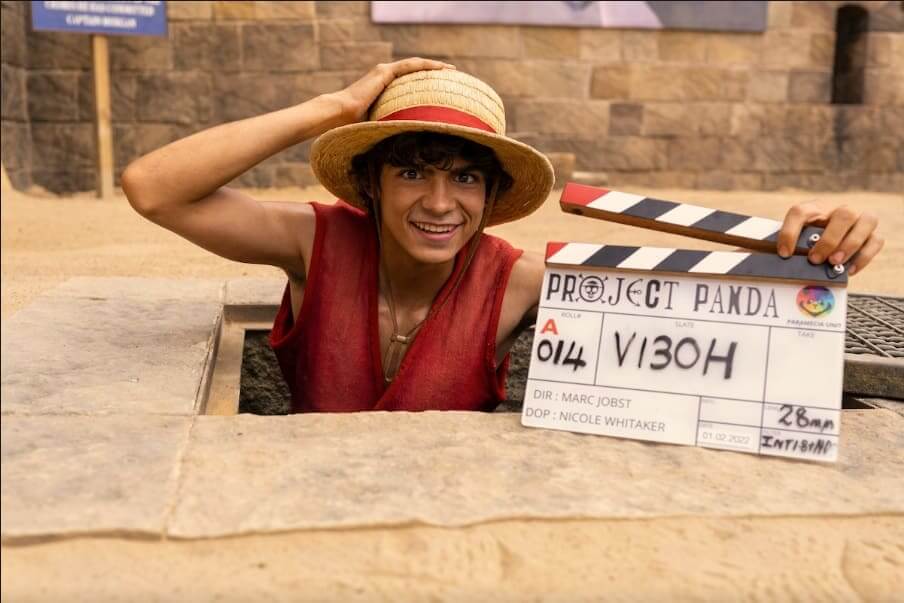
Picture: Iñaki Godoy as Luffy – Joe Alblas/Netflix
Jacob: The size and scale of what this story has become over the past 25 years of Oda’s writing, one of the biggest challenges posed to you in the first season is establishing this world is larger than what viewers realize.
Eric: Matt is a huge One Piece fan. He was pretty clear about that, and that’s great. Growing up, I was a comic book kid, and I’m still somewhat aware of many of my fan favorites. I obviously worked for Marvel for seven years. So I’m very much in tune with that world. So we were very aware going into the show knowing that other anime hadn’t translated so well [into live action] in the past. We were a little concerned, but every time we expressed concern, we realized this felt good and right, at least for me.
I think all of the other editors would say the same, and I know Emma, my director, felt that way. You were falling in love with the characters that you were putting together. You’d want to take a step back and be objective and critical, but in the same breath, the fan in me is kicking in here, and I’m really enjoying what I’m looking at.
In episode three, I had Usopp and Kaya, and that’s where these two are introduced in the story. You just fell in love with these two. You could relate to how they feel, how they love each other, but hide their love for one another. It brings back a lot of happy childhood memories. You can connect with those types of people.
Take Zoro. He has aspirations; his dream is to be the best swordsman ever, and everyone can sort of connect to an aspiration like that. They want to be the best at whatever their dream is, so these were characters that were easy to connect with because they were played well by the actors but also well-written and well-directed.
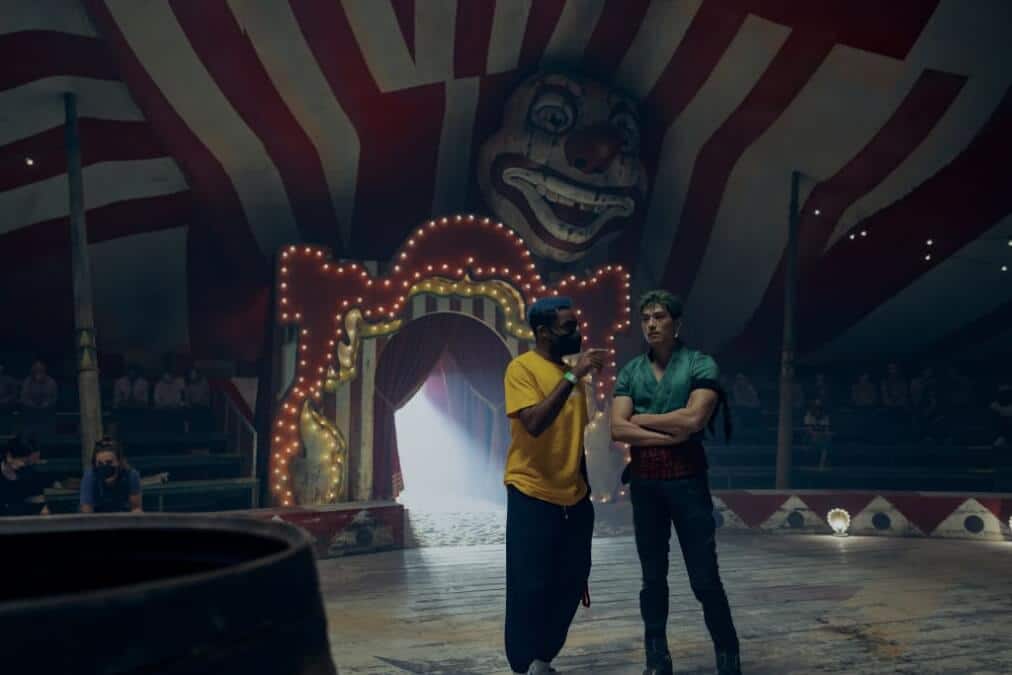
Pictured: EP Matt Owens, Mackenyu Arata as Roronoa Zoro in season 1 of One Piece. Photo: Netflix
Since working on the series, would you say you’re a fan now?
Eric: Yeah. When I got hired to do the show, I had a few months before I started. So I watched several episodes of the anime on Netflix, and I was really into it. It was just a really captivating show. I then went into my local comic book store, picked up a lot of the manga, and wanted to be familiar with that. As I’m sure everyone can understand, there’s a lot to get through, and I’m still getting through a lot.
There’s a lot of material, which is cool because I have some general ideas about where things will potentially go for season two. But there are so many avenues and so many stories that they can touch on. It’s really kind of exciting.
Jacob: Will you be working on the second season?
Eric: I hope so. They’ve expressed interest in that. And we’ve had some, Hollywood has had a bit of a pause at the moment, and so once they start up production, I will be there. Just give me a call, and I’ll be there.
Who is your favorite character in One Piece so far?
Eric: Well, oh man, tough question because they’re all so good. I guess I have a personal bias toward Usopp, Zoro, and Kaya. It was mainly because they were so much fun to cut and put together. Kaya and Usopp in episode three, there’s a whole scene where they’re discussing their love for each other, Usopp to Luffy, Kaya to Nami. They were just really, really great scenes.
The way it was written, the way it was shot, and the way it was initially cut they were just linear scenes that followed one after the other. The performances were great, they just took time, and you found yourself sometimes waiting too long. I believe we got a note from Oda asking if it was okay to truncate this. Is there a way to intercut these scenes? To Matt and Steve’s credit, they gave me the note, and they said, see what you can do. We’ll take your time, and that was one of the luxuries of One Piece. I was given a lot of time and I was given a lot of initial creative freedom to explore these things. So I took some time, and I figured it out.
I saw that you can intercut those scenes and change a couple of lines of dialogue, making it more of a question-answer section. I was able to intercut those scenes. So one person would say, would raise a question and then cut to the next scene and then Usopp or Kaya would answer. It just really put the two together, and it made them feel like they were both on the same page, even though they were trying to hide their true feelings. So I was really proud of that section.
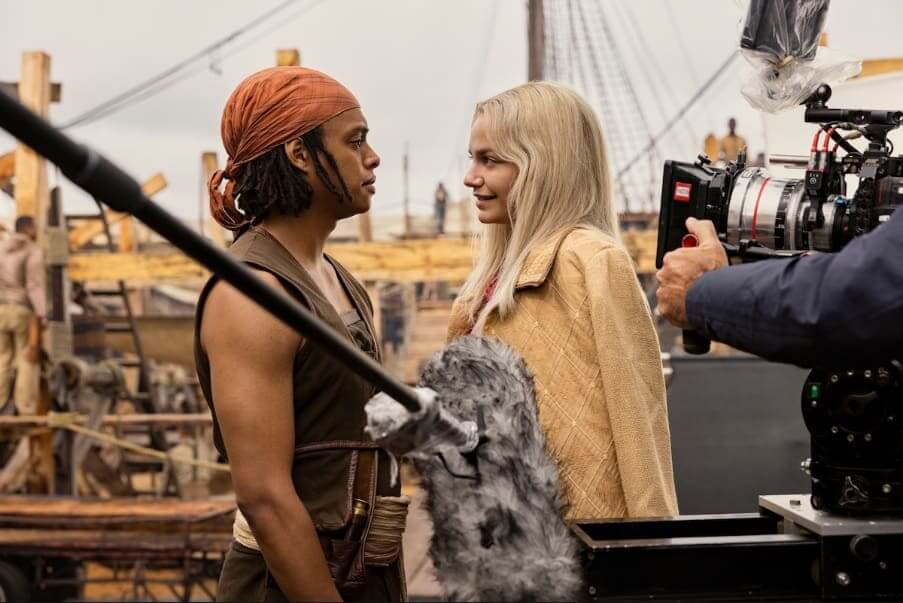
Picture: Jacob Romero as Usopp and Celeste Loots as Kaya – Casey Crafford/Netflix
The same goes for episode four with Zoro, one of my fan favorites. Zoro’s in the well, flashbacking to the Kuina’s funeral, making his declaration to be the best swordsman out there in the world, and again, those scenes were just linear. Again, they were well done and beautifully shot, specifically young Zoro with the sensei against the lake. Just absolutely gorgeous footage. Similar note, can we intercut this? Can we move this along a little faster? I was given a fair amount of time to figure that out.
The great thing about that section is Emma shot a lot of footage of present-day Zoro climbing up the well. She got a lot of footage, close ups of his face, a lot of footage of his hands and his feet struggling to get up the well. It gave me a lot of options.
So, in the original version, it was all just linear. I couldn’t use it all because there just wasn’t a place for it. But with the intercut, we were able to find it in the edit, use more footage, and give more emotional impact to his aspirations and what he’s thinking, and I’m just absolutely thrilled with how both those scenes turned out, how we discovered it in the edit.
What are you looking forward to for the future of the One Piece live-action series?
Eric: Well, I hear there’s potentially some interesting casting coming our way for season two. I did see on Instagram that potentially Jamie Lee Curtis would be very interesting. I’m a massive fan of hers to have an opportunity to work with her would be amazing. But, you know, I’m just looking forward to returning with a really good group of people working on a great show.
Have you watched the One Piece live-action series on Netflix? Let us know in the comments below!
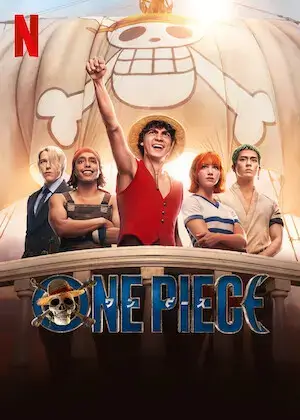 Rating: TV-14
Rating: TV-14